

Vietnam and Laos study trip
March 20, 2014

The group was led by the coordinator of the NSW Crawford Fund committee, Dr Bruce Standen. Members include the former Dean of Agriculture, Prof Lester Burgess, cattleman Dick Austen, rural commentator Neil Inall, exotic animal disease expert Dr Helen Scott-Orr and Marchien van Oostende for the Crawford Fund Head Office.
On Monday they went to the Quynh Luong Commune north of Vinh. The commune of 200 hectares grows a wide variety of horticultural crops, ranging from Bok Choy to tomatoes, cabbage, onions and peanuts. The crops are harvested each day and trucked to major Vietnamese cities. Each plot within the commune is less than 0.2 of one hectare and is farmed by one of the 200 families.

The group was accompanied by the technical manager for the Plant Protection Sub Department in the Nghe An province, Mr Tring Lam who said “farmers in the area face severe disease problems including a soil fungus in peanuts which can wilt the crop and cause plant death”.
Professor Burgess said “with tighter rotations in the region, soil borne diseases are on the increase like pythium root rot in tomatoes and control of some insect pests is becoming more difficult as they develop resistance to common insecticides, like spider mite. Vietnams mild climate is very suitable for the development of soil borne diseases.” He believes the introduction of planting material from overseas could be the source of many diseases like south rice black streak virus and passionfruit wilt.
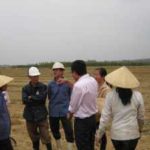
On Tuesday the group went to see the drastic effects of green grassy shoot disease in sugar cane in the Nghia Dan district.
Dr Huat, head of Plant Pathology research at the National Plant Protection Institute in Hanoi, told us the disease can cut sugar yields by 50% in their second year of production and up to ninety percent in their third year of growth. He said: “At the moment the vector which spreads the disease has not been identified, despite intense research”. Later we saw the effects of fusarium wilt in water melon crops. The disastrous result can be curtailed by grafting watermelon seedlings onto gourd rootstock. The system has been adopted very succesfully in other parts of the world and its value has yet to be demonstrated to farmers in this province. We also learnt that more corn is being grown in the region because of the growing demand for grain from the intensive animal industries.
Vietnam Academy of Agricultural Science (VAAS)
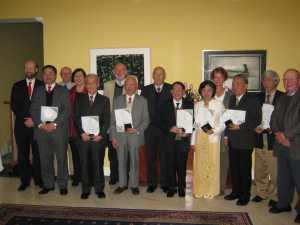 On Thursday the group attended formal discussions with Dr Nguyen Van Bo, director of the Vietnam Academy of Agricultural Sciences (VAAS). He is dedicated to enhancing research and training in agricultural science at the national level. He says it is a crucial part of rural development in Vietnam.
On Thursday the group attended formal discussions with Dr Nguyen Van Bo, director of the Vietnam Academy of Agricultural Sciences (VAAS). He is dedicated to enhancing research and training in agricultural science at the national level. He says it is a crucial part of rural development in Vietnam.
Dr Bo says there are major issues for the rice industry… the thousands of hectares of riceland which is lost to urbanisation each year, up to 30 or 40,000 hectares per year, and losses in the industry from rats and mice during the growing period. On top of that post harvest losses in the industry can be as much as 50%.
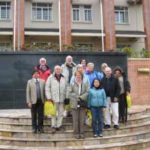
Dr Bo said there is a big need for Vietnamese scientists to learn English, especially those planning to undertake higher degrees. He is also concerned at the loss from the institute of good young scientists to plant breeding, animal feed, plant protection and fertiliser companies.
The group was later hosted at the Embassy by ACIAR and met with Mr Allaster Cox, Ambassador to Vietnam. In the evening the Ambassador presented seven medals to distinguished agriculturalists for their continued contributions to agriculture.
Recipients were; Professor Cu Xuan Dan, former rector of Hani Agriculture University; Madame Dao Thi Minh Hang, Head of the Department of Ethnic and Religious Affairs; Professor Ha Minh Trung, former director of the Plant Protection Research Institute; Professor Le Dinh Ka, former director of the Research Centre for Forest Tree Improvement; Professor Le Viet Ly, former vice director of the National Insitute of Animal Husbandry; Dr Le Than Luu, Director of Research Institute Aquaculture No1 and Dr Nguyen Van Bo, Director of VAAS.
The Northern Mountainous Agriculture and Forestry Science Institute (NOMAFSI)
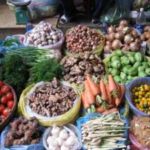 The group was amazed at the size and extent of the Institute. Established by the French in 1918 it has recently been enlarged and modernised with funding from the Asian Development Bank. The research focus at the Institute is on coffee, tea and fruit. The Institutes’ Director General, Dr Le Quoc Doanh, said “One of the most serious problems in the mountainous region is landslides and soil erosion. There is a regulation which limits clearing on steep slopes, but it is not strictly enforced”.
The group was amazed at the size and extent of the Institute. Established by the French in 1918 it has recently been enlarged and modernised with funding from the Asian Development Bank. The research focus at the Institute is on coffee, tea and fruit. The Institutes’ Director General, Dr Le Quoc Doanh, said “One of the most serious problems in the mountainous region is landslides and soil erosion. There is a regulation which limits clearing on steep slopes, but it is not strictly enforced”.
As the group moved further west towards Sa Pa, the group saw plenty of evidence of extensive deforestation of very steep slopes.
Lao Cai markets and vegetable processing plant in Lao Cai
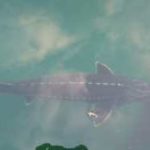
In Lao Cai Dr Newman took the group to the local markets where regional producers sell their wares. Apart from vegetables there was meat, fish, fruit and rice available. When asked if most people now buy their fresh food in supermarkets, Dr Hien told us that people will buy their fresh foods at the markets, not at a supermarket. “They want to be sure it is fresh”, she told us.
Before travelling on to Sa Pa the group was taken to a vegetable processing plant where 70 people work in three shifts, every 24 hours (60 of them women) to process vegetables for export to taiwan, Korea, Laos and cambodia. The main export article is fried onions, made from localy grown shallots. Other products include chilled vegetables.
Cold fresh water fisheries
NSW Crawford Committee member, Dr Helen Scott-Orr says it was amazing to see the cold water aquaculture research facility near Sa Pa. There, apart from rainbow trout, Chinese as well as Russian sturgeon are being reared (with Finnish and Russian technology) to populate mountain lakes and improve the food and income of ethnic Vietnamese minorities in the region.
The group was told that an important issue for the fish farming industry in Vietnam, is that most of the feed for the fish has to be imported. The expanding livestock feeding industry in Vietnam is facing a similar problem.
Vegetable research
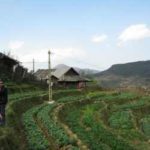
On Saturday afternoon, 19 March, the group was shown vegetable research blocks by Dr Suzie Newman, who is leading the ACIAR project on “change in the marketing and production of indigenous vegetables by women (ACIAR AGB/2006/112). The aim of this project is to improve farm income in rural areas of Vietnam by increasing the skills of women in the safe production, promotion and utilisation of indigenous vegetables. There are six vegetable varieties under study and the group saw first-hand how some trials and demonstrations have been set up.
Sa Pa Commune trial
The group was taken to an area within the Sa Pa commune, where a trial has started with local minority ethnic farmers. Here the project looks at incorporating vegetables in the rice rotation to hopefully lift incomes rather than leaving rice land fallow after harvest. Already the neighbouring farmers were copying the trial.
Bac Ha
At Bac Ha Dr Suzie Newman took the group to observe a training course for seventeen women farmers which was held on Monday afternoon, 21 March. The farmers learnt the theory of making compost before going to vegetable gardens to put theory into practice. The Women’s Union of Vietnam are actively involved in the project.

The same afternoon the group was told by Dr Bob Nissan from Queensland DEEDI, of his research into grafting of persimmon trees to lift their productivity. Traditionally the farmers are very reluctant to adopt radical pruning techniques.
The group also visited a trial site where farmers were encouraged to intercrop vegetables with their plum trees. As with the persimmon trees, farmers reluctantly adopt the practice of pruning trees and thinning of young fruit.




